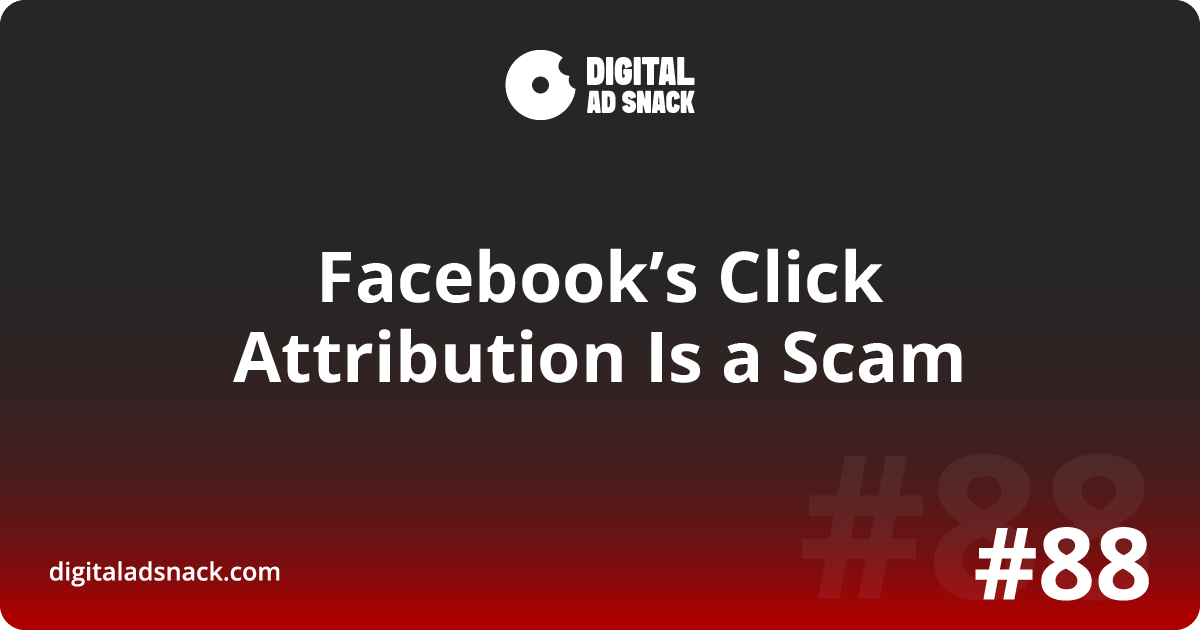Streamline Your Marketing Workflow With These Free Excel Templates
Are your spreadsheets helping you move faster—or slowing you down?
Masters in Marketing’s free Excel Toolkit includes 10 customizable templates used by real marketing teams to plan smarter, track better, and stay organized across campaigns.
Inside this toolkit, you’ll get:
A campaign planning template that keeps teams aligned
A content calendar format built for busy marketers
Budget and performance trackers designed to show ROI fast
Plug-and-play sheets that require zero complex formulas
Unlock the toolkit. Free when you subscribe to the Masters in Marketing newsletter.
Get practical marketing insights, twice a week, from experts who know what works.
Meta didn’t tweak your ads. It tweaked your metrics.
If you’ve been watching clicks, there’s a good chance you’ve been chasing the wrong signals.
Because here’s the truth: most of the clicks you see in Ads Manager don’t mean what you think they do.
Clicks are useful in certain cases, they tell you if your ads are interesting enough to get a tap.
Meta didn’t change what a click means — it finally confirmed what most advertisers feared.
Let’s break down what’s really going on and how to fix it before your data lies to you again.
The Click Illusion
For years, marketers assumed “link clicks” in Ads Manager actually meant link clicks — users actually visiting a website or landing page.
But Meta’s definition has always been unclear.
Now it’s official: a click means any click — including likes, shares, comments, and saves.
So if someone double-taps your carousel or clicks “See more” on your ad copy, that’s a click.
If that person buys within a day (or seven), Meta will claim the conversion.
The result? Your reports look inflated.
You might see a high CTR and a low CPC, but those numbers are padded with social interactions — not site visits.
It’s not fraud — it’s just misleading by omission.
The metric looks good, but it doesn’t measure intent.
You’re not getting more traffic.
You’re just getting more clicks that don’t matter.
The Only Click That Counts
If you’re going to track clicks at all, there’s only one type that matters:
Outbound Clicks.
Outbound clicks represent users who actually leave Facebook or Instagram and visit your website.
They’re your true intent signal—the people who took action beyond engagement.
To get a realistic view of performance, start tracking:
Unique and Total Outbound Clicks - the clicks that actually lead to your site.
Outbound Click-Through Rate (OCTR) - the % of users who actually left the Meta platform.
Cost per Outbound Click (CPOC) - what you’re paying per real visitor.
These metrics strip away the noise.
You’ll immediately see how few of those “clicks” were genuine traffic drivers.
And once you make that shift, your cost metrics might spike but your clarity improves tenfold.
Remember: your goal isn’t cheap clicks.
It’s qualified actions that move the users towards conversion.
The Real Attribution Problem
Even when you fix your click metrics, attribution on Meta is still messy.
Here’s why:
Meta’s system credits itself for conversions within the attribution window — 1, 7, or even 30 days, depending on your settings.
So if someone likes your ad on Monday, searches on Google on Friday, and converts there—Meta still claims that sale.
In reality, both platforms played a role, but Meta’s click attribution doesn’t recognize shared influence.
Google’s data-driven attribution distributes credit based on actual contribution.
Meta’s model? Binary.
If it touched the user, it takes the win.
This doesn’t mean Meta isn’t powerful — it’s still a top ad platform.
But if you take its reporting at face value, you’ll keep optimizing for ghosts.
The smarter move?
Use Meta’s in-platform data to optimize creatives and engagement.
Always cross-check Meta reports with your own platform reports.
Bottom line
Meta didn’t scam you. It just made it really easy to scam yourself.
Simplify your metrics.
Focus on outbound clicks, conversions, ROAS, POAS (Profit on Ad Spend), and of course, business metrics such as revenue and profit.
Because if you can’t trust the data, you can’t trust the decisions that come from it.
🍩 Snackable Challenge
Open Ads Manager today and add these metrics to your performance view to show:
✅ Unique and Total Outbound Clicks
✅ Outbound CTR
✅ Cost per Outbound Click

Meta Ads Custom Metrics - Outbound Clicks
Then compare them to your standard “clicks” and “CTR.”
You’ll see how inflated the old numbers were.
From now on, measure intent—not noise.
Help me write better content for you. Answer these 2 questions:
Are my emails too long?
How did you like this issue? (Be honest please)
♥️ Tools we love to use at my agency:
My ultimate list of FREE Ad Libraries for spying on competition and inspiration
Get my FREE Facebook Ads Hook Library and make it yours.
My favorite FREE newsletters on Ads & Media Buying.
For Ad Creative Inspiration in almost every niche: Magritte.
Use code: RENE10 to get 10% OFF.
#1 Newsletter Builder platform for founders, creators, writers (website, automations, quizzes) Beehiiv.
Get 30-days Free Trial + 20% OFF for 3 months with this link.
Email Marketing tools for e-commerce Klaviyo or Mailerlite. We choose the one that fits our client’s needs between these two.
Best Pop-up Tool for e-commerce to grow your email list: Optimonk
Link in Bio and mini-website builder for Instagram & TikTok we use Taplink.
Our go to No-Code Drag & Drop website and landing page builder with 170+ prebuilt templates: Sitejet
* If you click the links above, we may receive a tiny commission that helps keep Digital Ad Snack running—thank you!
An espresso shot for your brain
The problem with most business news? It’s too long, too boring, and way too complicated.
Morning Brew fixes all three. In five minutes or less, you’ll catch up on the business, finance, and tech stories that actually matter—written with clarity and just enough humor to keep things interesting.
It’s quick. It’s free. And it’s how over 4 million professionals start their day. Signing up takes less than 15 seconds—and if you’d rather stick with dense, jargon-packed business news, you can always unsubscribe.




